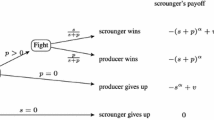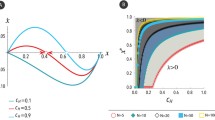Summary
The Hawk-Dove game (Maynard Smith, 1982) has been used to analyse conflicts over resources such as food. At the evolutionarily stable strategy (ESS), either a proportionp* of animals always play Hawk, or each animal has a probabilityp* of playing Hawk. We modify the standard Hawk-Dove game to include a state variable,x, that represents the animal's level of energy reserves. A strategy is now a rule for choosing an action as a function ofx and time of day. We consider a non-reproductive period and adopt the criterion of minimizing mortality over this period. We find the ESS, which has the form ‘play Hawk if reserves are belowc* (t) at timet, otherwise play Dove’. This ESS is very different from the ESS in the standard Hawk-Dove game. It is a pure ESS that depends on the animal's state and on time. Furthermore, it is characterized by the strong condition that any single mutant that does not adopt the ESS suffers a reduction in fitness. The standard Hawk-Dove game assumes pay-offs that are related to fitness; our approach starts from a definition of fitness and derives the pay-offs in the process of finding the ESS. When the environment becomes worse (e.g. food becomes less reliable or energy expenditure increases) the ESS changes in such a way as to increase the proportion of animals that will play Hawk.
Similar content being viewed by others
References
Balph, M. H. (1977) Winter social behaviour of dark eyed juncos: communication, social organization and ecological implications.Anim. Behav. 25, 859–84.
Bishop, D. T., Cannings, C. and Maynard Smith, J. (1978) The war of attrition with random rewards.J. Theor. Biol. 74, 371–88.
Enquist, M. and Leimar, O. (1987) Evolution of fighting behaviour: the effect of variation in resource value.J. Theor. Biol. 127, 187–205.
Grafen, A. (1987) The logic of divisively asymmetric contests: respect for ownership and the desperado effect.Anim. Behav. 35, 462–7.
Hinde, R. A. (1952) The behaviour of the Great Tit and some other related species.Behaviour (Supplement)2, 1–201.
Hines, W. G. S. (1987) Evolutionary stable strategies: a review of basic theory.Theor. Pop. Biol. 31, 195–272.
Houston, A. I. and McNamara, J. M. (1987) Singing to attract a mate: a stochastic dynamic game.J. Theor. Biol. 129, 57–68.
Ketterson, E. D. (1978) Environmental influences upon aggressive behavior in wintering juncos.Bird-Banding 49, 313–20.
Lockie, J. D. (1956) Winter fighting in flocks of Rooks, Jackdaws and Carrion Crows.Bird Study 3, 180–90.
McNamara, J. M. and Houston, A. I. (1982) Short-term behaviour and life-time fitness. InFunctional Ontogeny (D. J. McFarland, ed.) pp. 60–87. Pitmans, London.
McNamara, J. M. and Houston, A. I. (1986) The common currency for behavioural decisions.Amer. Natur. 127, 358–78.
Marler, P. (1955) Studies of fighting in chaffinches (1). Behaviour in relation to the social hierarchy.Brit. J. Anim. Behav. 3, 111–17.
Marler, P. (1956) Studies of fighting in chaffinches (3). Proximity as a cause of aggression.Brit. J. Anim. Behav. 4, 23–30.
Maynard Smith, J. (1982)Evolution and the Theory of Games. Cambridge University Press, Cambridge, UK.
Maynard Smith, J. and Price, G. R. (1973) The logic of animal conflict.Nature 246, 15–18.
Parker, G. A. (1984) Evolutionary stable strategies. InBehavioural Ecology (J. R. Krebs and N. B. Davies, eds) pp. 30–61. Blackwell Scientific Publications, Oxford, UK.
Pulliam, H. R., Anderson, K. A., Misztal, A. and Moore, N. (1974) Temperature-dependent social behaviour in juncos.Ibis 116, 360–4.
Riechert, S. E. and Hammerstein, P. (1983) Game theory in the ecological contexts.Ann. Rev. Ecol. Syst. 14, 377–409.
Stokes, A. W. (1962) Agonistic behaviour among blue tits at a winter feeding station.Behaviour 19, 118–38.
Author information
Authors and Affiliations
Rights and permissions
About this article
Cite this article
Houston, A.I., McNamara, J.M. Fighting for food: a dynamic version of the Hawk-Dove game. Evol Ecol 2, 51–64 (1988). https://doi.org/10.1007/BF02071588
Issue Date:
DOI: https://doi.org/10.1007/BF02071588




